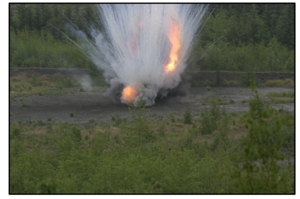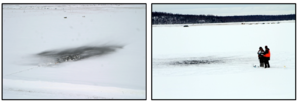User:Debra Tabron/sandbox
The firing and detonation of munitions will result in the deposition of unreacted energetic compounds. These materials, in sufficient concentrations, can be harmful to the environment and human health. The mass of energetics residue also indicates the efficiency of the activity, be it firing or detonation of the round or the disposal of propellants or unexploded ordnance. Quantifying energetics deposition is the basis for fate and transport analysis and modeling, range sustainment capabilities, and determining the toxicological impacts of munitions compounds.
Related Articles:
CONTRIBUTOR(S): Michael Walsh
Key Resource(s): Characterization of PAX-21 Insensitive Munition Detonation Residues.[1]
Introduction
Live-fire military training is an integral part of combat readiness. During this training, energetic materials such as explosives, propellants, and pyrotechnics are expended. Research conducted at the US Army’s Cold Regions Research and Engineering Laboratory has demonstrated that during training activities, some energetic material always remains[2][3][4]. These materials can migrate to groundwater and possibly off range, jeopardizing human health and the sustainability of our military’s range assets. Very large environmental liabilities can be incurred because of energetics contamination ranges, such as has occurred at the Eagle River Flats impact area on the former Ft. Richardson, AK, and the Massachusetts Military Reservation on Cape Cod, MA[5][6].
Deposition can occur during any one or more of the following range training activities: Firing the munition, detonation, disposal of a malfunctioned munition (referred to as a “blow-in-place” [BIP] operation), and disposal of excess propellant charges (Fig. 1). Propellants, explosive loads, and pyrotechnic loads or tracers all contain energetic materials that can be recovered following a training activity.
Determining Energetics Deposition
The efficiency of a detonation will have a major influence on the environmental impact of that munition on a training range. Detonation efficiency can be characterized in several manners. Commonly used methods include measuring the shock (blast) wave intensity, measuring the fragmentation size and pattern, and estimating energetic residues from detonation combustion products. A new approach is to use detonation residues deposition mass estimates to directly determine environmental impact.
Mass deposition refers to the mass of energetics remaining after an operation involving munitions is completed. These energetic residues are measured on the surface of ranges or in surface and groundwater[7][8]. The residues mass may be measured as estimated total mass remaining, as a percentage of the original mass of energetics involved in that operation for the munition, or as a soil concentration. Soil concentrations were originally examined, but it was not possible to parse out the sources of the residues or the contribution a specific munition or munition type had on the overall deposition.
The need to detect very small masses of energetics led to testing of munitions on a clean, uncontaminated surface, snow or ice, which allows for quantification of energetics residues on a per-round basis without interference from past training activities. The ability to develop an energetics residue mass estimate for a single round enabled the determination of the efficiency of a round with respect to specific operations, such as firing, detonation, or disposal. Refinement, and in some cases development, of analytical methods for propellants and explosives enabled the breakdown of efficiencies into those for individual energetic compounds within formulations. This gives a more detailed indication of where problems may occur during training as well as which operations or munitions will have less impacts on ranges and thus enable sustainable range operations.
Mass Deposition Experiments on Snow
Mass deposition measurements of munitions detonations first occurred in response to the closure of the Eagle River Flats (ERF) impact area on Fort Richardson in Alaska[9]. Howitzer rounds were fired into the Flats in winter to try to determine if explosives or white phosphorus could be detected in the residues deposited on the snow surface[10]. A sampling process was developed for residues on snow, but sampling bias and cross-contamination from prior range activities proved problematic until testing was moved to an impact area underlain by ice in 2002 (Fig. 2) [11]. In 2004, winter tests conducted on snow-covered ice by at the ERF impact area demonstrated that estimates of per-round energetic residues can be obtained using the recently developed, multi-increment sampling protocol[12]. All detonation tests have since been conducted using a variation of this method[13]. The method is constantly refined, with several quality assurance procedures incorporated, as well as streamlining of the initial sample processing and reduction of cross contamination of samples in the field and the lab.
Results for 20 years of detonation testing have been compiled into a database. Munitions tested include howitzer, tank, and mortar rounds, hand and rifle grenades, demolitions materials, mines, and rockets. Tests include live-fire, blow-in-place (BIP), simulated and actual low-order detonations, and close-proximity detonation testing. Testing of newly developed insensitive munitions is now being conducted using command detonations of the rounds rather than firing them into the impact area as the rounds are in the process of certification. An excerpt from the database is shown in Table 1. The full database is much more detailed, with data on each energetic component in the explosive formulation.
References
- ^ Walsh, M.R., Walsh, M.E., Taylor, S., Ramsey, C.A., Ringelberg, D.B., Zufelt, J.E., Thiboutot, S., Ampleman, G. and Diaz, E., 2013. Characterization of PAX‐21 Insensitive Munition Detonation Residues. Propellants, Explosives, Pyrotechnics, 38(3), pp.399-409. doi: 10.1002/prep.201200150
- ^ Walsh, M.R., Walsh, M.E., Poulin, I., Taylor, S. and Douglas, T.A., 2011. Energetic residues from the detonation of common US ordnance. International Journal of Energetic Materials and Chemical Propulsion, 10(2). doi: 10.1615/IntJEnergeticMaterialsChemProp.2012004956
- ^ Walsh, M.R., Walsh, M.E., Ampleman, G., Thiboutot, S., Brochu, S. and Jenkins, T.F., 2012. Munitions propellants residue deposition rates on military training ranges. Propellants, Explosives, Pyrotechnics, 37(4), pp.393-406. doi: 10.1002/prep.201100105
- ^ Walsh, M.R., Walsh, M.E. and Hewitt, A.D., 2010. Energetic residues from field disposal of gun propellants. Journal of Hazardous Materials, 173(1), pp.115-122. doi:10.1016/j.jhazmat.2009.08.056
- ^ Walsh, M.E., Walsh, M.R., Collins, C.M. and Racine, C.H., 2014. White phosphorus contamination of an active army training range. Water, Air, & Soil Pollution, 225(6), pp.1-11. doi: 10.1007/s11270-014-2001-2
- ^ Clausen, J., Robb, J., Curry, D. and Korte, N., 2004. A case study of contaminants on military ranges: Camp Edwards, Massachusetts, USA. Environmental Pollution, 129(1), pp.13-21. doi: 10.1016/j.envpol.2003.10.002
- ^ Jenkins, T.F., Hewitt, A.D., Grant, C.L., Thiboutot, S., Ampleman, G., Walsh, M.E., Ranney, T.A., Ramsey, C.A., Palazzo, A.J. and Pennington, J.C., 2006. Identity and distribution of residues of energetic compounds at army live-fire training ranges. Chemosphere, 63(8), pp.1280-1290. doi: 10.1016/j.chemosphere.2005.09.066
- ^ Thiboutot, S, Ampleman, G. Brochu, S., Diaz, E, Martel, R., Hawari, J., Sunahara, G., Walsh, MR, and Walsh, ME, 2013. Canadian programme on the environmental impacts of munitions. 1st European Conference on Defence and the Environment, Helsinki, Finland. Presentation
- ^ Racine, C.H., Walsh, M.E., Roebuck, B.D., Collins, C.M., Calkins, D., Reitsma, L., Buchli, P. and Goldfarb, G., 1992. White phosphorus poisoning of waterfowl in an Alaskan salt marsh. Journal of Wildlife Diseases, 28(4), pp.669-673. doi: 10.7589/0090-3558-28.4.669
- ^ Collins, C.M. and Calkins, D.J., 1995. Winter tests of artillery firing into Eagle River Flats, Fort Richardson, Alaska. US Army Corps of Engineers, Cold Regions Research & Engineering Laboratory. Report pdf
- ^ Jenkins, T.F., Walsh, M.E., Miyares, P.H., Hewitt, A.D., Collins, N.H. and Ranney, T.A., 2002. Use of snow-covered ranges to estimate explosives residues from high-order detonations of army munitions. Thermochimica Acta, 384(1), pp.173-185. doi: 10.1016/S0040-6031(01)00803-6
- ^ Walsh, M.R., Walsh, M.E., Ramsey, C.A. and Jenkins, T.F., 2005. An examination of protocols for the collection of munitions-derived explosives residues on snow-covered ice (No. ERDC/CRREL-TR-05-8). US Army Cold Regions Research and Engineering Laboratory, Hanover, NH USA. Report pdf
- ^ Walsh, M.R., Walsh, M.E. and Ramsey, C.A., 2012. Measuring energetic contaminant deposition rates on snow. Water, Air, & Soil Pollution, 223(7), pp.3689-3699. doi: 10.1007/s11270-012-1141-5

